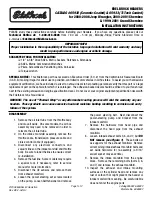
||
DRIVER SUPPORT
350
warnings and instead leads to City Safety giving a
warning at a later stage.
The
Late
warning distance should therefore only
be used in exceptional cases, as in dynamic driv-
ing.
WARNING
•
No automatic system can guarantee
100% correct function in all situations.
Therefore, never test City Safety by driv-
ing at people, animals or vehicles - this
may cause severe damage and injury and
risk lives.
•
City Safety warns the driver when there is
a risk of a collision, but it cannot shorten
the driver’s reaction time.
•
Even if the warning distance has been set
to
Early
warnings could be perceived as
being late in certain situations, e.g. when
there are large differences in speed or if
vehicles ahead suddenly brake heavily.
•
With the warning distance set at
Early
,
the warnings will come more in advance.
This may mean that the warnings come
more frequently than at the warning dis-
tance
Normal
, but it is recommended
since it can make City Safety more effec-
tive.
The warning with direction indicators for Rear
Collision Warning is deactivated if the warn-
ing distance for collision warning in the City
Safety function is set at the lowest level
"
Late
".
The seat belt pre-tensioning and braking
functions are, however, still active.
Related information
•
•
Rear Collision Warning (p. 360)
Detection of obstacles with City
Safety
City Safety can help the driver to detect vehicles,
cyclists, large animals and pedestrians.
Vehicles
City Safety detect most vehicles that are station-
ary or moving in the same direction as the driver's
own car. This function can also detect oncoming
vehicles and cross traffic in certain cases.
In order that City Safety shall be able to detect a
vehicle in the dark, the vehicle's front and rear
lights must be working and clearly illuminated.
Cyclists
Optimal examples of what City Safety interprets as a
cyclist — with clear body outline and bicycle outline.
Optimal performance requires that the system
function that detects a cyclist must receive the
clearest possible information about the body and
Summary of Contents for XC90 Twin Engine 2019
Page 1: ...XC90 T W I N E N G I N E OWNER S MANUAL...
Page 2: ......
Page 17: ...OWNER S INFORMATION...
Page 26: ......
Page 27: ...YOUR VOLVO...
Page 32: ...YOUR VOLVO 30 The owner s manual and the environment p 23 Air quality p 204...
Page 42: ......
Page 43: ...SAFETY...
Page 70: ...SAFETY 68 Table for location of ISOFIX child seats p 71 Seatbelts p 44...
Page 81: ...DISPLAYS AND VOICE CONTROL...
Page 151: ...LIGHTING...
Page 165: ...WINDOWS GLASS AND MIRRORS...
Page 183: ...SEATS AND STEERING WHEEL...
Page 203: ...CLIMATE...
Page 244: ......
Page 245: ...KEY LOCKS AND ALARM...
Page 265: ...KEY LOCKS AND ALARM 263 Country Area Type approval Oman Serbia...
Page 268: ...KEY LOCKS AND ALARM 266 Country Area Type approval Oman Serbia...
Page 290: ......
Page 291: ...DRIVER SUPPORT...
Page 416: ......
Page 417: ...HYBRID INFORMATION...
Page 433: ...HYBRID INFORMATION 431 LED lamp 1 LED lamp 2...
Page 445: ...STARTING AND DRIVING...
Page 510: ......
Page 511: ...SOUND MEDIA AND INTERNET...
Page 565: ...WHEELS AND TYRES...
Page 591: ...LOADING STORAGE AND PASSENGER COMPARTMENT...
Page 610: ......
Page 611: ...MAINTENANCE AND SERVICE...
Page 635: ...MAINTENANCE AND SERVICE 633 Fuses in engine compartment p 634 Fuses under glovebox p 638...
Page 664: ......
Page 665: ...SPECIFICATIONS...
Page 699: ......
Page 700: ...TP 27080 English Int AT 1846 MY19 Copyright 2000 2018 Volvo Car Corporation...
















































